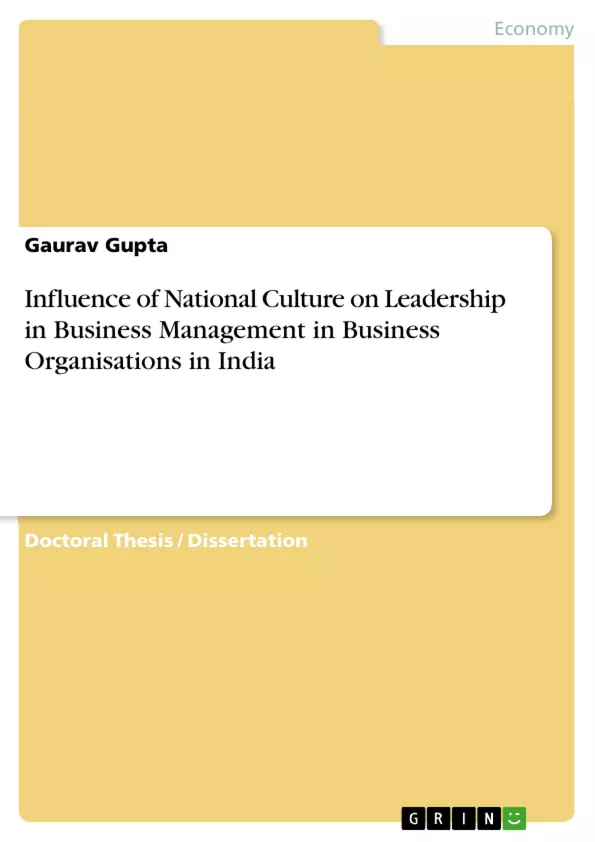This paper investigates the influence of national culture on the aspect of leadership in business management in business organisations in India. The current level of globalisation is very high in the existing business scenario, due to which interactions between people from different nations and from different cultural backgrounds for business purposes is happening at a high rate. People from different nations carry the cultural perceptions and beliefs of that nation and construe different meanings to the same situation. Thus the understanding of the cultural norms & practices of different nations can be helpful in understanding why a person behaves in a given situation. Also, the development of the skill of cultural intelligence can be a valuable asset and those managers which posses this skill can be more successful and obtain better results in business dealings. The cultural variables as propounded by the seminal author Hofstede, namely power distance, individualism & collectivism, masculinity & feminity, and uncertainty avoidance, were used in this research. As per the previously done research by the seminal author Hofstede, India was ranked high in the power distance index, moderate in the individualism index, moderate in the masculinity index, and low in the uncertainty avoidance index. The findings have indicated the power distance in India is lower than what has been previously found out. Also, the cultural variable of masculinity & feminity has been found to be leaning more towards feminity rather than masculinity which is again opposed to the results as previously propounded. The findings have corroborated with the results as obtained by previous research regarding the cultural variables of individualism & collectivism and uncertainty avoidance, that individualism & collectivism is moderate and uncertainty avoidance is low in India. The findings have led to the conclusions that, currently in India, the leaders in business organisations cannot impose themselves on the subordinates and expect unquestioning obedience. The leaders have to be understanding and have to view the subordinates as a valuable part of the management team in a business organisation. Also the findings have indicated that the personnel in leadership positions in business organisations in India, are coming in contact with people of different nations, and not all, but some of the business organisations are providing training on cultural awareness & intelligence to its personnel.
Inhaltsverzeichnis (Table of Contents)
- 1. Introduction
- 1.1 Introduction to this section.
- 1.2 Background
- 1.3 Aim and Objectives
- 1.4 Selection of a specific country
- 1.5 Structure of the dissertation.
- 2. Culture and Its Impact on Business…........
- 2.1 Introduction
- 2.2 National Culture.
- 2.3 Culture and Globalisation
- 2.4 Cultural Differences
- 2.5 Culture Variables.....
- 2.5.1 Power distance.......
- 2.5.2 Individualism and Collectivism......
- 2.5.3 Masculinity and Feminity.
- 2.5.4 Uncertainty Avoidance....
- 2.6 Leadership and Culture......
- 2.6.1 Cultural intelligence.
- 2.7 Background on India
- 3. Methodology.....
- 3.1 Introduction to this section.......
- 3.2 Research Paradigms.
- 3.2.1 Positivistic paradigm.
- 3.2.2 Phenomenological paradigm
- 3.3 Selection of Research Paradigm.…..........\n
- 3.4 The Case Study method.
- 3.5 Data Collection Method
- 3.6 Research Limitations ..........\n
- 3.7 Research Ethics
- 4. Findings and Discussion
- 4.1 Introduction to this section.
- 4.2 Background of business organisations….......
- 4.2.1 United Phosphorus Limited
- 4.2.2 Olam International Limited.
- 4.2.3 WNS.
- 4.2.4 Hughes Systique Corporation
- 4.2.5 Mudra Group
- 4.2.6 BCC Research
- 4.3 The Empirical Evidence
- 4.3.1 Question 1.
- 4.3.2 Question 2.
- 4.3.3 Question 3.
- 4.3.4 Question 4....
- 4.3.5 Question 5.
- 4.3.6 Question 6...\n
- 4.3.7 Question 7.
- 4.3.8 Question 8....
- 4.3.9 Question 9.
- 4.3.10 Question 10....
- 4.3.11 Question 11.
- 4.3.12 Question 12.
- 4.3.13 Question 13.
- 4.4 Analysis of the findings.
Zielsetzung und Themenschwerpunkte (Objectives and Key Themes)
This paper investigates the influence of national culture on leadership in business management within Indian business organizations. The research aims to understand how cultural variables, such as power distance, individualism, masculinity, and uncertainty avoidance, impact leadership styles and practices in India. The study examines these cultural influences through the lens of Hofstede's cultural dimensions. Key themes explored in this research include:- The influence of national culture on leadership styles in India.
- The impact of cultural variables on business management practices in India.
- The role of cultural intelligence in managing diverse teams within Indian organizations.
- The relationship between cultural dimensions and leadership effectiveness in India.
- The challenges and opportunities associated with managing cultural diversity in Indian business organizations.
Zusammenfassung der Kapitel (Chapter Summaries)
The first chapter provides an introduction to the research, outlining the background, aims, objectives, and structure of the dissertation. It also explains the rationale for selecting India as the specific country for this study. Chapter two delves into the concept of culture and its impact on business, specifically focusing on national culture, globalization, cultural differences, and the cultural variables proposed by Hofstede. It also explores the relationship between leadership and culture, including the concept of cultural intelligence. The chapter concludes with a background on India's cultural context. Chapter three discusses the methodology employed in the research, including the research paradigms, the selection of the case study method, data collection methods, research limitations, and ethical considerations. Chapter four presents the findings and discussion based on the empirical evidence gathered from six business organizations in India. It analyzes the findings in relation to the cultural variables and explores the implications for leadership in Indian business organizations.Schlüsselwörter (Keywords)
This research focuses on the influence of national culture on leadership in business management within Indian organizations. Key terms and concepts explored include: national culture, cultural variables (power distance, individualism, masculinity, uncertainty avoidance), leadership styles, cultural intelligence, globalization, business management practices, and India.- Quote paper
- Gaurav Gupta (Author), 2011, Influence of National Culture on Leadership in Business Management in Business Organisations in India, Munich, GRIN Verlag, https://www.grin.com/document/298278



